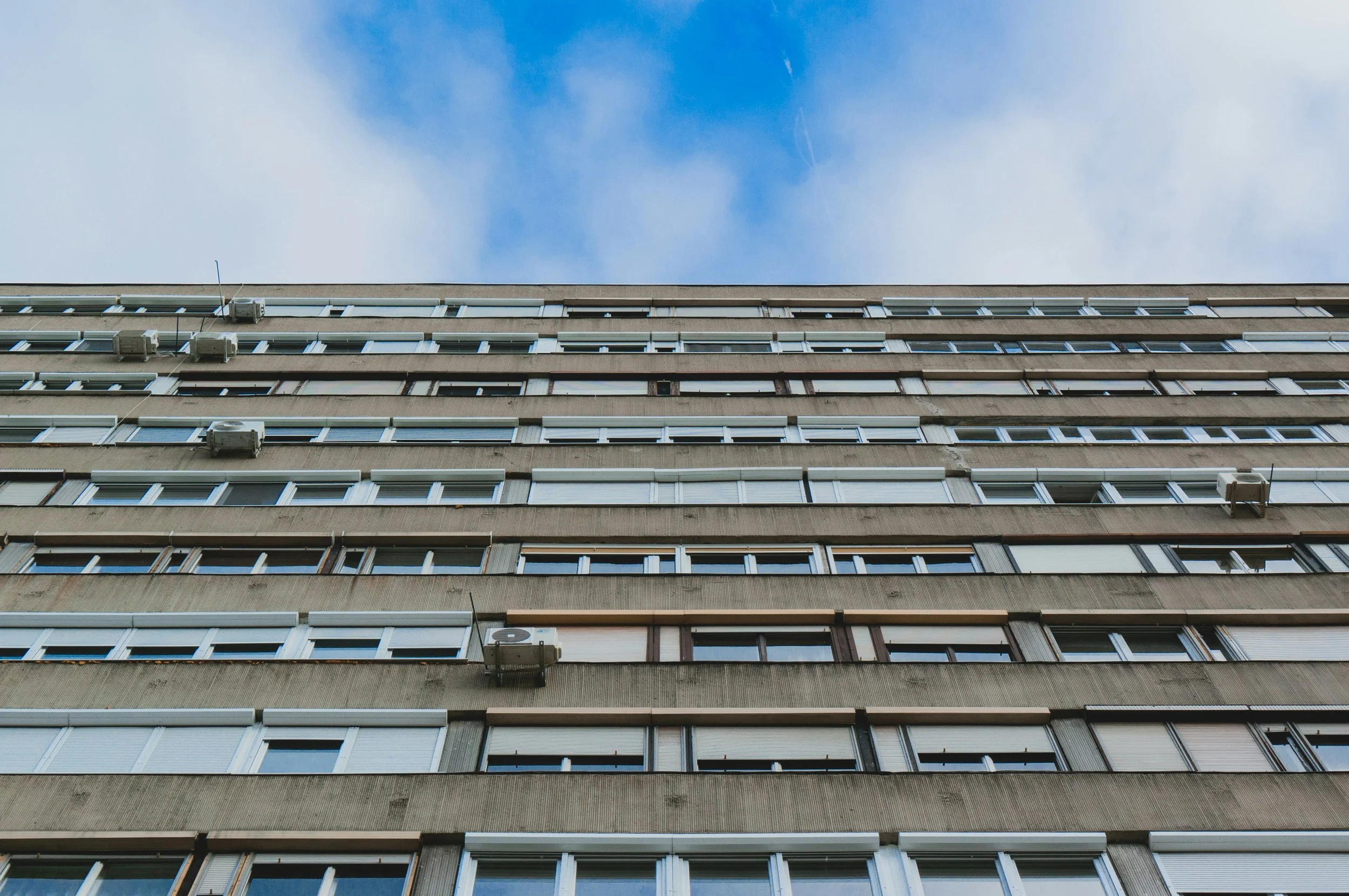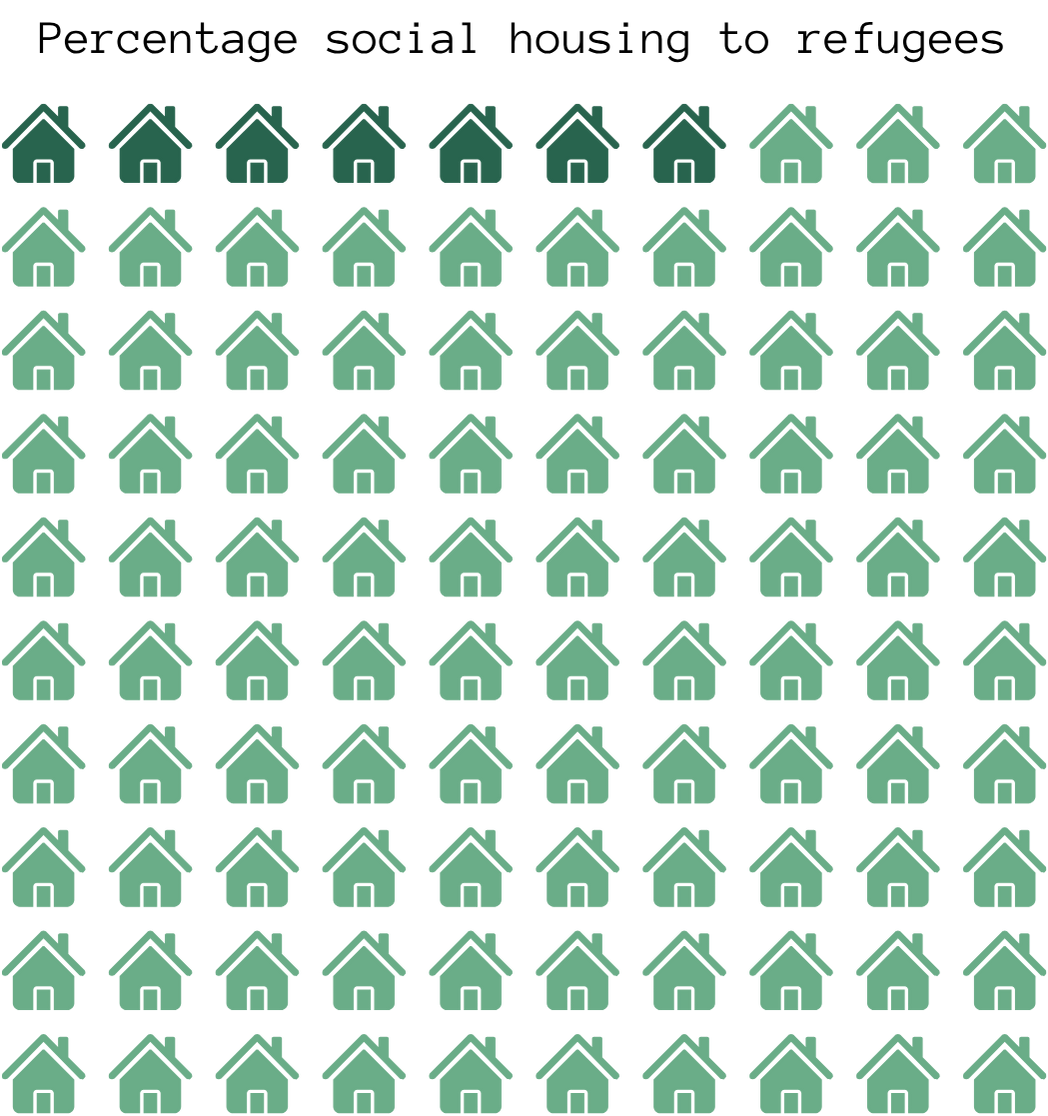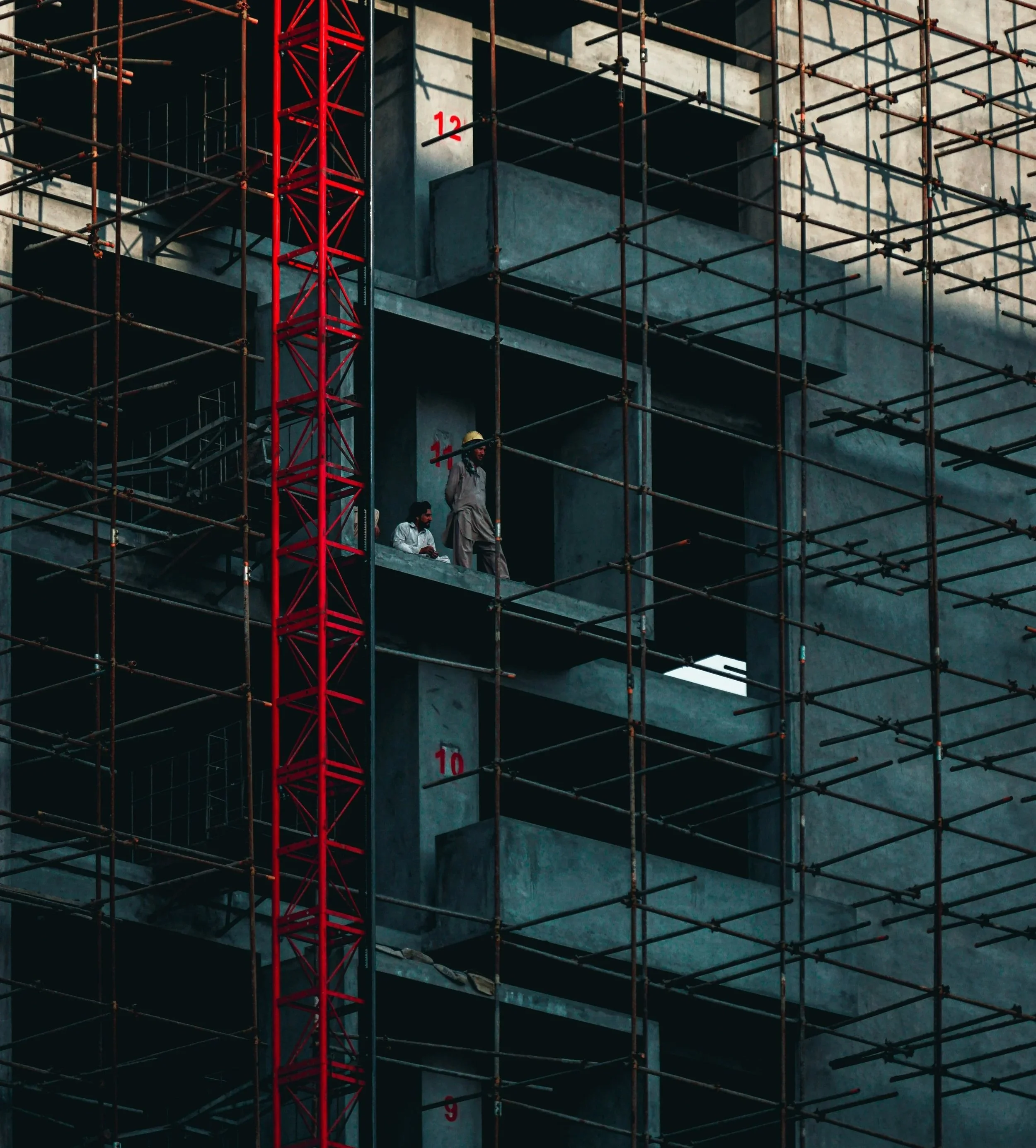
Immigration problem? Or a policy problem?
The Netherlands is facing a pressing issue that needs to be addressed: a severe shortage of available housing. According to the Ministry of Housing and Spatial Planning (Volkshuisvesting en Ruimtelijke Ordening), there is a current shortage of 396.000 homes. As a result, many people struggle to find suitable housing. For example, many young adults and individuals with lower incomes are forced to live with their parents or share cramped apartments.
The impact of the housing crisis goes beyond a shortage of appropriate living spaces. As the number of households grows without enough places to accommodate them, prices and rents have surged.
The impact of immigrants
What does all this have to do with immigration? Many narratives about the current housing shortage in the Netherlands attribute it to immigrants. 78% of people allowed to vote believe it is harder to find a home because of the presence of refugees. The UN's Special Rapporteur on Adequate Housing emphasises the importance of understanding the actual role foreigners play in the housing crisis. The claim that they are to blame, which is neither proven nor likely, is used to radicalise and divide people. The Rapporteur found that immigrants and refugees are negatively impacted by the housing crisis, rather than being its cause.
The Netherlands faces a shortage of about 400.000 homes. Refugees and immigrants do not account for that amount of housing. In 2022, approximately 7% of newly available social housing was allocated to households with at least one refugee. In other words, roughly 11.000 places go to households containing a refugee, compared to about 150.000 homes allocated to non-refugee households. In addition, immigrants often have a lower socio-economic status, meaning they usually seek more affordable housing options that most Dutch people without a migration background do not qualify for nor want.
Immigrants have an even lower impact on the issues in the housing market for buyers. At the beginning of 2024, foreign buyers accounted for around 1.8% of all house purchases. Since immigrants comprise a small percentage of all homebuyers, they have a negligible impact on the housing market as a whole.
In short, immigrants and refugees do contribute to a small share of the (social) housing demand. However, they are not the primary drivers of the Dutch housing crisis. Narratives framing migrants, especially asylum seekers, as the main problem are not backed up by data, and they could distract us from focusing on the core issues of the system.
“They called, telling me I got a house. I had been waiting for so long that I could not believe it. I had to ask her again. It just felt unrealistic”
The main causes of the housing crisis
If immigrants are not the leading cause of the housing crisis, what is? The housing shortage in the Netherlands is driven by multiple interconnected factors that continue to shape the housing market. Previous policies did not effectively counteract these trends, which contributed to the current shortage.
Demographic factors
A few demographic trends complicate the current housing situation. For example, an increased number of families are looking for housing. This increase in households is partly due to the growing population, but the main reason for this growth is the shrinking size of households. In 1995, approximately 2.1 million people lived alone. Now, this has risen to roughly 3.4 million people, and this upward trend is only expected to continue. Meanwhile, the construction of small homes remains limited.
The aging of the population also plays a role. Seniors are a large and growing group, often living in homes that could otherwise house larger families. Some simply prefer to stay in their own home, but seniors who want to move are often not able to since there are not enough alternatives available. By 2050, the share of people aged 65+ is predicted to rise to nearly 25% of the population, amplifying the need for age-appropriate, barrier-free homes.
The housing shortage is not just about the type of homes available; the location matters too. Since 1990, the number of people living in bigger cities has grown significantly. This urbanisation is only expected to continue, making the provision of housing in these areas increasingly difficult.
Changes in the market
Another concerning trend is that both rents and home prices continue to increase.
As a result, many people have to spend a significant part of their income on housing, which makes it harder to afford other necessities and leads to more social inequality. The growth of privatisation -in which investors buy properties to let, instead of individuals owning their own homes- has reduced the number of affordable options for citizens with low- or middle-incomes.
On the other hand, new housing development has slowed down due to licences, strict regulatory requirements, and a shortage of skilled construction workers. Besides that, existing opportunities for housing are not being fully used. Tourism and websites like Airbnb have encouraged the conversion of homes into short-term rentals. Additionally, many empty business buildings that could be repurposed as new homes remain unused.
“The most difficult part was being kept out of the loop. You are kept out of the process of your life. All they tell you is that it is ‘in progress”
How did the crisis start?
Experts emphasize that the crisis was not inevitable. The housing policies implemented by the Dutch government have been central to both the emergence and persistence of the housing shortage in the Netherlands.
During the twentieth century, the government made significant investments in the development of social housing. However, starting in the late 1980, government involvement slowly decreased. Policy makers have put more responsibility on the private sector and social housing associations, expecting them to take the lead in financing, developing, and managing affordable housing, whilst cutting back on subsidies and direct investment. This shift in responsibility was amplified after the financial crisis in 2008. At the same time, changes in the Dutch population like smaller families, urbanisation, and an ageing population, increased the demand for housing. As a result, too few new homes were built to keep up with the needs of a growing and changing population.
Social housing
From 1990 onwards, the government shifted from directly providing housing to delegating responsibility to semi-private non-profit housing associations. At first, this reduced costs and increased housing availability. However, as government oversight and support diminished, the sector's performance began to decline.
“In December 2015 I finally got my own place, I was incredibly happy. We did not have anything in the house, but I was just going to leave the asylum centre. I did not want to be there anymore [...] I had a feeling of ‘now it really starts”
Additionally, the landlord levy was introduced in 2013. This regulation required landlords with many properties to pay an extra tax: those with 10 or more houses between 2013 and 2018, and 50 or more from 2019 to 2023. As expected, this levy stopped the rise of monopolies in the rental sector. However, this tax had an unforeseen effect: housing corporations faced greater financial burdens and lacked the resources to invest in new social and affordable accommodations. This hindered the much-needed development of subsidized properties, leading to a shortage of social housing.
Although more social housing is being built today, its share of the overall housing market is still shrinking. The number of other properties is rising faster than the amount of social housing. This means that the percentage of accommodation that is social housing has decreased from 30% in 2012 to roughly 27% in 2024, a downward trend that is likely to continue.
Some hope
Recent policies offer hope for change. For example, the Affordable Rent Act was introduced in July 2024, which aims to address rising housing costs. The Dutch government has made an explanatory booklet outlining key information on this act.
In short, all accommodation is awarded points for quality, based on factors such as size, energy performance, facilities, and more. The number of points a property obtains determines the maximum rent that can be charged.
Social housing can reach a maximum of 143 points, and is subject to a separate rent cap. This means housing corporations are not allowed to charge more than € 879,66 per month, even if the rent would be higher based on the amount of points calculated.
The Affordable Rent Act introduced a similar ceiling for mid-priced rentals. Housing scoring between 144 and 186 points is now also subject to a maximum rent independent of their score. This measure is intended to make renting more affordable, especially for middle-income tenants who earn too much to be qualified for social housing, but not enough to afford regular rent.
Another promising development is the housing agreements made by Hugo de Jonge with all the Dutch provinces. These agreements determine how many homes must be delivered per province every year between 2022 and 2030. In total, they aim to deliver more than 900 thousand new homes, two-thirds of which fall in the category ‘affordable’. In short, these agreements should lead to more available, affordable housing.
These are two examples of policies that could help solve the housing problem. As Anoek Scheuten points out in her thesis, the recently implemented policies are a reason to be hopeful. Rather than depending on the market for a solution to the housing shortages, these policies give directions on how to move forward. Although the full effects of these policies can only be seen once they have been in use for longer, the progress is encouraging.
The housing crisis is a complex issue with many interconnected causes. Immigration does play a role in the demand for housing. However, it cannot be labeled as the main cause. Shrinking sizes of households, privatisation, and government policies are a few examples of other factors contributing to the housing shortage. Everyone suffers from this housing crisis, including immigrants. Nevertheless, the steps the government is taking to reduce the housing shortage do offer hope for a better housing market for everyone.
How do refugees get their homes?
Some people have misconceptions about how asylum seekers get housing once they receive a residence permit. A common belief is that refugees automatically get priority in the assignment of housing. This assumption is understandable, as it used to be the case until July 2017. Since then, however, refugees are usually placed on the regular waiting list. Municipalities can still decide to give people with a residence permit priority, but this is no longer automatically the case.
Here is an overview of how the housing process works:
After getting their residence permit, asylum seekers are assigned to a municipality responsible for providing suitable housing by the COA. The number of refugees allocated to each municipality is decided twice a year, based on the size of the municipality.
In most cases, asylum seekers are placed on the waiting list of the local social housing association. When they reach the top of the waiting list and a suitable house becomes available, it gets assigned to them. Refugees do not have a say in where they will live; they have to accept whatever becomes available. Families are usually housed in single-family homes, while young unaccompanied refugees may be placed in shared accommodations. Officially, municipalities have 10 weeks to find suitable accommodation once an asylum seeker receives their permit. However, many municipalities struggle to meet this requirement due to the shortage of available homes. As a result, many refugees remain in asylum centres or emergency locations for extended periods.
To read more about refugee centres, go here.
Interesting reads
A deep dive in the housing market of the Netherlands by Mike Langen, senior economist, housing market
Report from the United Nations on the housing situation in the Netherlands
A policy review on the Dutch housing crisis
The Story of Diaa
Refugees are affected by the housing crisis just as much as Dutch citizens without a migration background, according to UN research.
Diaa is one of many refugees who has experienced it. Diaa works as a chef at a restaurant, studies social work with the goal of eventually studying psychology, enjoys gaming, and would describe himself as a bit of a nerd. He is really thankful with the house he now lives in, but the process to achieve it was not easy.
“We were in a dire situation, but everywhere we went they told us they could not help”
Diaa arrived in the Netherlands in 2021 through family reunification, together with his sisters and mother. They were supposed to stay with his stepfather, but after two difficult months the situation became unbearable, and they had nowhere else to go. With no support network, they went to Ter Apel. After a short stay, they were told to leave because they ‘already had an address’, despite having no safe place to return to, being out in the winter evening, and having a minor with them. Overnight, they became homeless.
With no other options, Diaa reached out to a distant acquaintance. Despite not having spoken for years, he arranged a temporary place for them to stay and sent someone to pick them up. This act of kindness kept them off the streets during freezing weather.
They spent months in Zwolle trying to secure housing. Diaa worked to support his family, but high rent, long waiting lists, and repeated rejections from institutions left them stuck. The uncertainty took a toll on his mother’s health, and she eventually returned to her husband in Rotterdam, while Diaa and his sisters continued searching for a safe place to live.
Another acquaintance later offered them temporary shelter, giving them some stability. Eventually, they met someone at the sociale wijkteam (governmental help in a neighbourhood) who helped them apply for emergency housing. Due to an error in their account setup, they spent nine months responding to every housing offer before finally receiving priority.
When they were finally offered a house, a misunderstanding almost cost them the opportunity, but the social worker intervened and resolved the situation. After nearly two years of homelessness, they were finally able to move into a place of their own.
“If it wasn’t for all the kind people who took us in for no reason other than to help us, we would have been in the streets”
Diaa says he is deeply grateful for everyone who helped them along the way - and for the chance to finally have a home again. “Above all,” he says, “I’m grateful to have a bed after sleeping on couches and floors for two years.”







